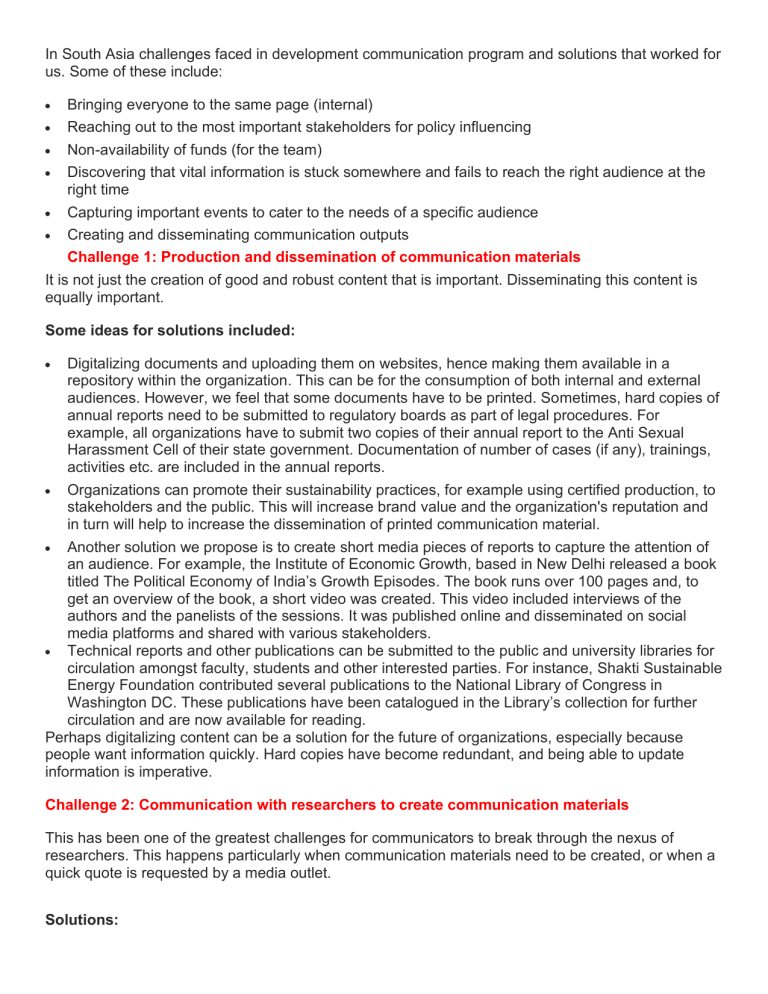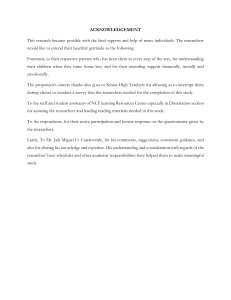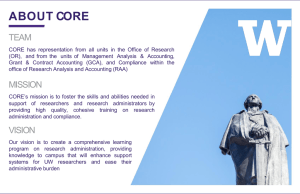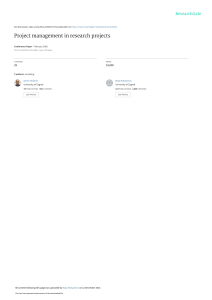
In South Asia challenges faced in development communication program and solutions that worked for us. Some of these include: • Bringing everyone to the same page (internal) • Reaching out to the most important stakeholders for policy influencing • Non-availability of funds (for the team) • Discovering that vital information is stuck somewhere and fails to reach the right audience at the right time • Capturing important events to cater to the needs of a specific audience • Creating and disseminating communication outputs Challenge 1: Production and dissemination of communication materials It is not just the creation of good and robust content that is important. Disseminating this content is equally important. Some ideas for solutions included: • Digitalizing documents and uploading them on websites, hence making them available in a repository within the organization. This can be for the consumption of both internal and external audiences. However, we feel that some documents have to be printed. Sometimes, hard copies of annual reports need to be submitted to regulatory boards as part of legal procedures. For example, all organizations have to submit two copies of their annual report to the Anti Sexual Harassment Cell of their state government. Documentation of number of cases (if any), trainings, activities etc. are included in the annual reports. • Organizations can promote their sustainability practices, for example using certified production, to stakeholders and the public. This will increase brand value and the organization's reputation and in turn will help to increase the dissemination of printed communication material. • Another solution we propose is to create short media pieces of reports to capture the attention of an audience. For example, the Institute of Economic Growth, based in New Delhi released a book titled The Political Economy of India’s Growth Episodes. The book runs over 100 pages and, to get an overview of the book, a short video was created. This video included interviews of the authors and the panelists of the sessions. It was published online and disseminated on social media platforms and shared with various stakeholders. • Technical reports and other publications can be submitted to the public and university libraries for circulation amongst faculty, students and other interested parties. For instance, Shakti Sustainable Energy Foundation contributed several publications to the National Library of Congress in Washington DC. These publications have been catalogued in the Library’s collection for further circulation and are now available for reading. Perhaps digitalizing content can be a solution for the future of organizations, especially because people want information quickly. Hard copies have become redundant, and being able to update information is imperative. Challenge 2: Communication with researchers to create communication materials This has been one of the greatest challenges for communicators to break through the nexus of researchers. This happens particularly when communication materials need to be created, or when a quick quote is requested by a media outlet. Solutions: • Having a good rapport with researchers, both at the project and individual levels, works well. Understand and learn the nuances of project proposals dialogue and discuss with researchers when clarifications are required. This can be done either in an informal way or through more formal meetings. Check-lists with a set of questions can be used to get the information you need from researchers to produce policy briefs, blogs or other communication materials. • Communicators must be aware of developments in their respective sectors, which will help them connect the dots and be able to assess the validity of a researcher’s inputs. Communicators must always double check data and facts- even researchers may inadvertently provide inaccurate information. • Innovative ideas and communication tools can work as catalysts to inspire researchers to provide their inputs. Senior researchers are busy with various external engagements which often make them unavailable for internal communication teams. Short videos or interviews with mid-level and junior researchers to share on social media can be very effective communication outputs. The Centre for Policy Dialogue (CPD) applies this strategy with the objective to communicate with its social media followers and quickly disseminate facts and information on contemporary issues. As social media platforms are gaining popularity rapidly among young generations in South Asia, this strategy serves both ways – in gaining expected response from the target audience and having required support and content from the research team. In short, work on a healthy and collaborative relationship between researchers and communicators from the start of a research project to the final output, along with innovative ideas to use appropriate communication tools will help address this challenge. Challenge 3: Fundraising for communications team In some organizations, there are no separate funds for the various activities handled by a communication team. Either they are included in a project or program or often do not have a stake. Solutions: • A strong component of communications should be included in all proposals. After all, most projects do require visibility and dissemination factors which in turn will raise the brand of an organization. • Experienced team members can be encouraged to provide consultancies to other organizations. The organization may have to look at the legal aspects of providing consultancies. The experience of individuals in a communication team can be used to provide professional services at a fee. For example, a graphic designer can design logos, standees, banners or publications during events. After all, every organization wants to have quality results in terms of design and content. • In some cases, communication teams can be encouraged to write proposals to seek funds for their units. • Challenge 4: Enhancing the quality of research outputs All organizations are in the process of ensuring that the quality of research outputs are excellent. In fact, some funders have made this a mandate to organizations they support financially. Ideally a communications team is involved in this activity. Solutions: • • • Processes for publications can be established by introducing an editorial cycle which could include an aspect of peer review. Key outputs can be given a green flag by a person of authority in the organization. While most communication team members do not have a technical background, they are uniquely placed to review a report for logic and common sense






